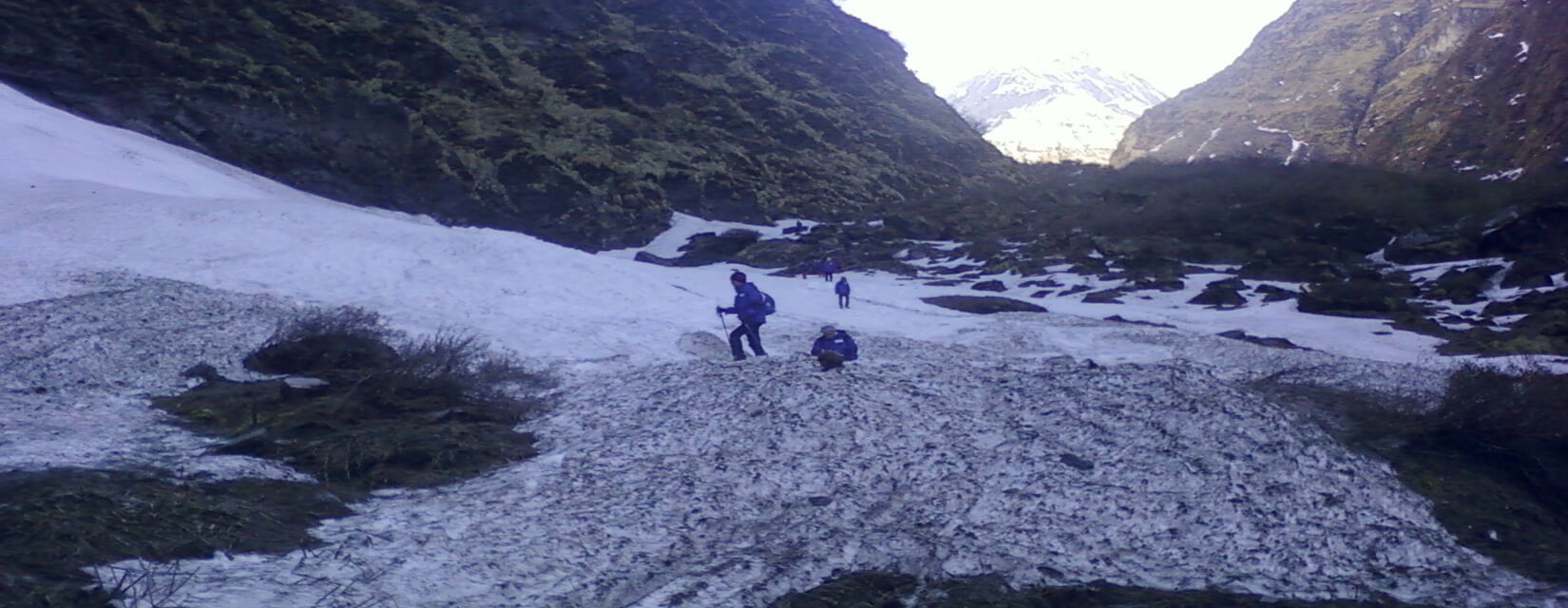About Annapurna Base Camp Trek | Best Trekking Packages in Nepal
Annapurna Base Camp Trek - ABC Trek 12 Days 2026
The Annapurna Base Camp Trek (ABC Trek) organized by Himalayan Asia Treks and Expedition Pvt Ltd is a breathtaking journey that takes adventurers through stunning landscapes and vibrant local cultures. The ABC Trek typically covers 5 to 7 days, covering approximately 70 kilometers (43 miles) of diverse terrain, with the highest point at 4,130 meters (13,550 feet) at the base camp. The ABC Trek Itinerary includes stops at picturesque villages, lush rhododendron forests, and spectacular mountain views, allowing trekkers to acclimatize and fully experience the Annapurna region. The cost of the trek varies based on the duration and included services, making it accessible to various budgets. Detailed maps and itineraries are provided to guide trekkers along the route, ensuring a memorable and rewarding experience in the heart of the Himalayas.
Trekking to Annapurna Base Camp is an unforgettable adventure in the breathtaking landscapes of Nepal. This ABC Trekking takes you through lush forests, charming villages, and eventually to the base of the majestic Annapurna massif. The cost of the Annapurna Base Camp Trek can vary depending on factors like the duration and services included. But it's generally affordable, making it accessible to a wide range of travelers. The trek reaches an altitude of approximately 4,130 meters.
The ABC Trek is offering stunning views of the surrounding peaks. It typically takes around 12 days to complete, allowing trekkers to acclimatize to the altitude gradually. While challenging at times, the trek consider moderately difficult, making it suitable for most hikers with a reasonable level of fitness. For a well-organized trek, many travelers choose to go with reputable trekking companies like Himalayan Asia Treks, which provide experienced guides and a safe, enjoyable experience.
Trekking from Pokhara Annapurna is a popular starting point for this remarkable trek.The Annapurna Base Camp Trek is a must-visit trek that takes you to the base of Mt. Annapurna. This fantastic trek takes place in the beautiful Annapurna region and follows the traditional route from Banthati and ends at Ghandruk. The Annapurna Base Camp Trek 12-days encompasses all the central parts of the Annapurna region. The trail presents gorgeous snow-capped mountains like Annapurna 1, Annapurna 2, Annapurna 3, Mt. Macchapucchre, Mt. Nilgiri, Mt. Gangapurna, and Mt. Dhaulagiri. Along with scenic views, the trail will also present you with diverse vegetation that increases the beauty of this region.
ABC Trekking takes you inside the buzzing cultures and traditions of the Chhetris and mostly Gurung people. The quaint settlements of Tadapani and Chhomrong are home to the people of Tamang and Gurung communities. At Ghandruk, you’ll visit the antique museum, highlighting the past and present of the Gurung people. Similarly, the trails load with prayer flags and millennium-old gompas that portray the cultural richness of the Annapurna region.
Annapurna Base Camp Trekking leads you to the majestic Annapurna region, which in turn takes place in the Annapurna Conservation Area. The Trek to Annapurna Base Camp begins from Kathmandu, a quick flight will lead you to Pokhara. Spend a night in Pokhara, and then head out to Banthati. Next, hike a lot of stairs and arrive at the Gurung settlement of Ghorepani. Next, head out to Poon hill to catch the fantastic views of snow-capped Himalayan Mountains like Dhaulagiri, Machhapuchhre, and Annapurna.
As the trail gains elevation, you will find yourself at Chhomrong, which lies near the Kimrong Khola. After spending a night in the Himalayas, you venture towards Machhapuchhre Base Camp and ultimately to Annapurna Base Camp. Views from Annapurna Base Camp include a picturesque display of the mountains governing the Annapurna landscape and small colorful tents that stand out in the white environment. After spending some time at Annapurna Base Camp, retrace your steps back to Bamboo, towards Ghandruk, and then ultimately to Pokhara, where this marvelous journey will end.
FAQ of Annapurna Base Camp Trek (ABC Trek):
How difficult is Annapurna Base Camp Trek?
The Annapurna Base Camp (ABC) Trek consider moderately challenging, making it suitable for trekkers with varying levels of experience. The difficulty of the trek largely depends on factors such as weather conditions, individual fitness levels, and acclimatization. The trail encompasses diverse terrains, including lush forests, terraced fields, and high-altitude alpine landscapes. The ascent involves steep sections, stone staircases, and some challenging stretches, but it is generally manageable for those in good physical condition.
How long does it take to hike Annapurna Base Camp?
The duration of the Annapurna Base Camp Trek varies based on the specific route taken and individual pacing. On average, it takes about 5 to 12 days to complete the trek, depending on factors like the starting point, acclimatization days, and side trips. The flexibility of the trek allows trekkers to customize their itinerary to match their preferences and fitness levels.
Is Annapurna Base Camp harder than Everest?
Compared to the Everest Base Camp Trek, the Annapurna Base Camp Trek is often considered less physically demanding. While both treks present their own set of challenges, the elevation gain and altitude-related difficulties are generally less pronounced on the ABC Trek. Everest Base Camp Trek(EBC Trek) involves higher altitudes and longer durations of exposure to harsh conditions, making it more strenuous for some trekkers.
Is ABC trek worth it?
Despite its challenges, the Annapurna Base Camp Trek regard as a rewarding and worthwhile adventure. The trek offers breathtaking panoramic views of the Annapurna and Machapuchare mountain ranges, as well as an opportunity to experience the rich cultural diversity of the region. The picturesque landscapes, friendly local communities, and the sense of accomplishment upon reaching the base camp contribute to making the Annapurna Base Camp Trek a highly recommended and fulfilling trekking experience.
Accommodations on Annapurna Base Camp Trek:
On Annapurna Base Camp Trek, you will spend the night in a lodge or guest house. The rooms will be on twin-sharing terms with little space and a few pieces of furniture. Likewise, bathrooms will also be on sharing basis. In Kathmandu and Pokhara, you will stay in a three-star hotel. Again, rooms will be significant with private washrooms.
ABC Trekking difficulty:
The Annapurna Base Camp Trek difficulty level is marked as moderate to difficult. The Trek is mark carefully, but some paths are prone to landslides. You have to do a lot of climbing and indulge in walking for at least 5 hours a day. If you wish to explore the Annapurna Base Camp, you need to be in the good physical condition and possess plenty of willpower. Travel with us to know the true meaning of thrill and adventure.
Best time to go on ABC Trekking:
The Annapurna Base Camp trek is one of the most popular trekking routes in Nepal. The ABC Trek is known for its stunning natural beauty and cultural richness. The best time for this trek largely depends on the weather and your personal preferences. Here's a description of the two main trekking seasons in the Annapurna region:
Autumn (September to November):
Best Time: Autumn consider the best time to trek to Annapurna Base Camp. The weather is stable, and the skies are generally clear, offering breathtaking views of the Annapurna and Dhaulagiri mountain ranges
- Weather: During this season, the days are pleasantly warm (15°C to 20°C ), and the nights are cool but not freezing (5°C to 10°C ). There is very little rainfall, making it ideal for trekking.
- Scenery: The landscapes are vibrant with blooming rhododendron forests, terraced fields, and lush greenery. You'll also have a chance to witness local festivals and interact with the warm-hearted locals.
- Crowds: Autumn is a popular time to trek, so expect moderate to high numbers of trekkers. It's advisable to book accommodations in advance.
Spring (March to May):
Second Best Time: Spring is another excellent time to trek to Annapurna Base Camp.
- Weather: The weather is similar to autumn, with warm days and cool nights. Temperatures range from 15°C to 20°C during the day and 5°C to 10°C at night. Spring also brings less rainfall.
- Scenery: The highlight of spring is the colorful display of wildflowers, including rhododendrons, orchids, and various other blossoms. The scenery is lush and vibrant.
- Crowds: Spring is a popular trekking season, but it generally sees fewer trekkers compared to autumn. Accommodations may still fill up, especially in the more popular teahouse locations.
While autumn and spring are the most popular and recommended times for the Annapurna Base Camp trek due to their favorable weather conditions. The trek can be done during other seasons as well, like winter and summer. However, winter (December to February) brings cold temperatures, snowfall, and the possibility of trail closures, while summer (June to August) sees monsoon rains and increased leech activity, making it less desirable for trekking.
Ultimately, the best time for the Annapurna Base Camp trek depends on your preferences and tolerance for weather conditions. If you seek clear skies and comfortable temperatures, aim for autumn or spring.



